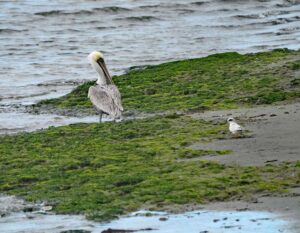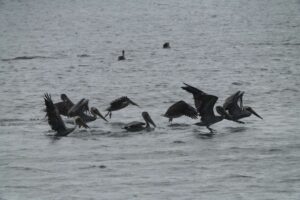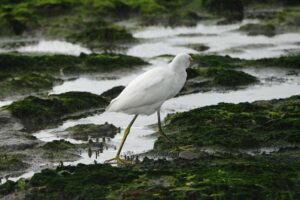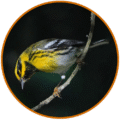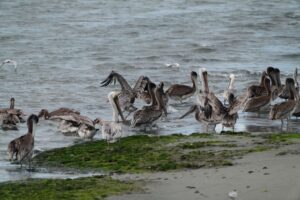
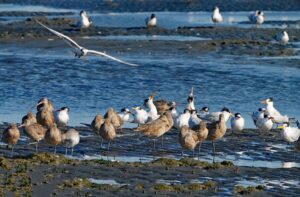
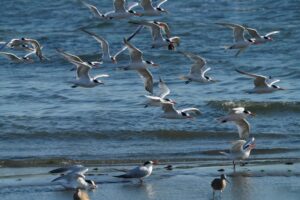
The first sign came in the darkness, long after sunset on a cool evening in early September. I lay in my Berkeley home, windows open to catch the bay breeze, when I heard them—the shrill, rattling cries of Elegant Terns cutting through the night air. Kree-eek, kree-eek—they called as they swarmed overhead, invisible messengers announcing summer’s approaching end. These sleek seabirds had just completed their breeding season in the Gulf of California, where many of them had nested in dense colonies on Isla Rasa. Now, they were coasting north to the Bay Area for a late-summer feeding extravaganza, following seasonal schooling fish, before riding the Pacific Flyway in October toward their winter refuges as far south as Peru. In that liminal hour between dusk and dawn, their cries felt like a secret shared between the migrating flocks and anyone awake enough to listen.
A week later, photographer Dick Evans and I found ourselves at the Elsie Roemer Bird Sanctuary in Alameda, drawn by the promise of witnessing this great seasonal transition firsthand. The sanctuary, tucked along the bay’s eastern shore on what was once an industrial landfill, has transformed into one of the region’s most important stopover sites for migrating shorebirds. Its 15 acres of restored salt marsh, mudflats, and upland habitat offer weary avian travelers exactly what they need: abundant food and safe roosting spots along the arduous Pacific Flyway.
The morning started clear, but as we walked the sanctuary’s perimeter, dark clouds rolled in, and we found ourselves caught in a sudden cloudburst. Wind whipped the pickleweed, and rain peppered the water’s surface in thousands of tiny explosions. Yet incredibly, the California Least Terns—barely larger than robins—continued fishing, diving headfirst into the choppy shallows among the raindrops and emerging with silvery fish in their needle-thin bills. These birds had spent their summer nesting along the shores of the Bay, and they seemed undeterred by a little Pacific weather. Elsie Roemer, whose sanctuary we walked through that morning, played an important role in saving the Northern California population of these birds from extinction. Soon these tiny terns would be turning south. Mysteriously, though they have been listed as endangered since 1970, scientists are still working to understand exactly where the California Least Terns go to overwinter along the Pacific Coast when they leave our shores!
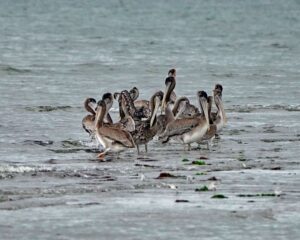
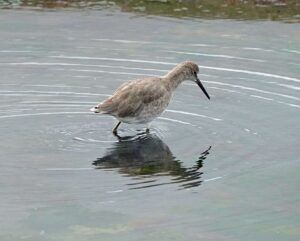
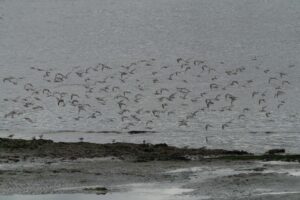
As quickly as it had arrived, the storm passed. The sun broke through the dispersing clouds, transforming the rain-soaked sanctuary into a gleaming tableau. The light revealed a remarkable congregation stretching along the shoreline.
Elegant Terns stood like white exclamation points along the water’s edge, their bright orange bills and punk-rock crests unmistakable even from a distance. These same birds that had called to me in the Berkeley night were now visible in daylight, having arrived in full force to take advantage of the bay’s rich waters to fuel up before turning south once more—some traveling a distance equivalent to flying from New York to London—twice!
Along the mudflats, Long-billed Curlews probed the sediment with their comically curved bills, perfectly calibrated to reach the marine worms and crabs buried below. These magnificent birds—North America’s largest shorebird—had likely just completed one of the most demanding legs of their journey, a non-stop flight south from breeding territories in the wind-swept grasslands of Alberta and Montana. There, curlews nest in shallow scrapes among buffalo grass and raise their young on a diet of grasshoppers and beetles. Now, they would use the Bay Area’s mudflats as a crucial refueling stop before some continue their epic journey all the way to Guatemala and Costa Rica. Their calls—prprprprpr prrreeep—resounded along the shoreline: a sound that has accompanied autumn migrations for millennia.
Nearby, mottled brown Marbled Godwits worked methodically with upturned bills, like avian archaeologists excavating the rich mud. These unassuming birds undertake an extraordinary journey, breeding in the pothole country of the northern Great Plains—a landscape of shallow wetlands scattered across prairie like jewels on green velvet—then flying non-stop across the entire breadth of North America to winter along the Pacific coast. Some of these very birds standing before us had flown the equivalent distance of Los Angeles to New York City without a single rest stop, navigating by stars and magnetic fields across mountain ranges, deserts, and vast stretches of farmland. For many, San Francisco Bay would become their winter home for the next six months, making it one of their most important refuges along the entire Pacific coast.
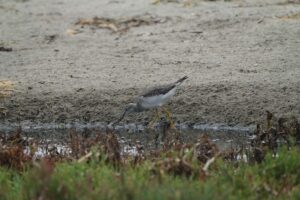
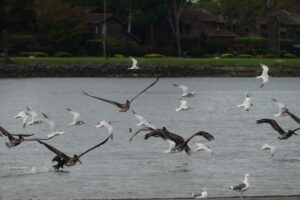
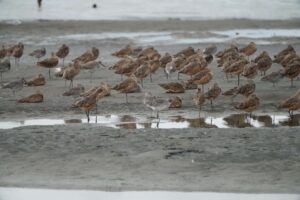
As the morning wore on and the post-storm light grew stronger, the full spectacle came into focus. Different species were stacked along the beach according to their feeding preferences: a living demonstration of how the Bay Area serves as a crucial intersection for some of the planet’s most remarkable journeys. The shorter-legged species claimed the drier areas: Black-bellied Plovers in their subtle gray winter plumage picked at surface prey with quick, stop-and-go movements. These arctic nomads had traveled from tundra nesting grounds across Alaska and northern Canada (imagine vast expanses of spongy moss and lichen stretching to the horizon under the midnight sun!), where they’d raised their chicks on crane flies and other insects during the brief arctic summer. Now they faced a journey that would take some as far as Argentina—a distance equivalent to flying around the entire circumference of the Earth at the equator.
Greater Yellowlegs waded through standing pools of water higher in the marsh, balancing on their bright yellow stilts, heads bobbing as they wove among egrets. These long-distance athletes had made their way to our collective front yard from the mossy bogs and boreal forests of Canada and Alaska. Standing on the beach that morning, it was clear that we were at a crossroads—so many of the birds in front of us were traveling paths connecting faraway ecosystems, from high boreal forests to the Great Plains to Central America and beyond. Threats along any of these stopovers represent a threat to the entire web of connection. Witnessing them all in the same place gave me an even deeper appreciation for the nonprofit Point Blue, which conducts research and conservation projects across 14 different countries, in recognition that conservation challenges in the Bay Area are not only local, but global.
We stood onshore—Dick’s camera still shedding bright raindrops from the summer storm—and watched Western Willets take flight, their bold black and white wing stripes flashing in the changing light. Each species had found its perfect niche in this recovered landscape.
Behind this remarkable assembly, the San Francisco skyline gleamed in the clearing air, the glass towers of the Financial District catching the sun. It was a striking juxtaposition—these ancient travelers, following routes established long before humans walked the earth, now finding refuge in the shadow of one of the world’s most iconic cities. I wondered how many other city dwellers, windows cracked in the late summer night, had listened as I had to the voices of those midnight travelers, and had lain awake with wonder. To live in the Bay Area is to live connected to something far larger than ourselves: that great seasonal current that pulls us all—birds and humans alike—to the teeming shore.
